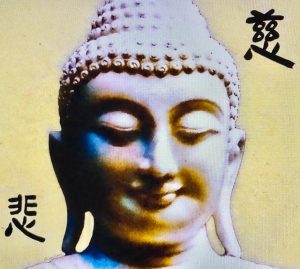
A playful deconstruction of the ubiquitous Buddha grin, and the telltale smile of real transformation.
Remember the last time you went to the spa, and you saw a stone Buddha? As the therapist elbowed deep into your erector spinae, Buddha’s reassuring, grandfatherly smile somehow managed to calm you, and the pain in your back and your life felt more manageable.
Buddha’s smile can generate some ‘pleasure contagion’ just by looking at it. We instinctively like him. Buddha seems like a good guy. Just as well because he is everywhere these days, even under your neighbour’s hydrangeas, grinning like a blissed-out gnome on Molly. There is an army of reassuring fat-boy sculptures right across the city, meditating discretely in coves, while at the same time appearing to be enjoying something slightly sexy. What is going on under those robes anyway, we might ask of the smiling statue at the drug store, while we stand in the line-up renewing our own anti-depressants.
There he is again at the airport, as we traverse the busy concourse, smiling down on us, reminding us to breathe and relax, despite climate change and mutant viruses. What is WITH that heavily branded smugness that wall-papers just about every sushi bar across the planet? What does it/he even represent?
No doubt that monetized grin means one thing to religious practitioners, and something completely different to the factory workers in Thailand that are churning out thousands of concrete Buddhas for export. They must wonder where all those smiles are going … probably into the private bathrooms of the slightly constipated, middle-management of the working West.
As we go about our frowning, sleep-deprived lives Buddha’s mildly disturbing smile appears to indicate a kind of cosmic foreplay that we are not party to. We are left out of it. Somehow that contented grin seems to be everywhere – except in our own mirrors. He sits impossibly still, and comfortably alone, and yet that smile seems to be in relation to something very pleasurable. It’s like an erotic PDA – but with no partner and no parental guidance warning. He seems to be deep in his own solitary joy, and we are reminded that we are not feeling ‘that’, whatever ‘that’ is, as we clamber our way up the corporate ladder to that private zen bathroom.
Yet that smile is not exactly ‘porn-star-face’ either, composed to titillate adolescents late at night in their bedrooms. That ecstatic smile, which may well have given its name to a rapture-inducing party drug, seems to be a signifier of some deeply embodied truth. It is the facial tic of a meditative practice that has the potential to change people utterly. From the inside.
This face is originally attributed to a princely sage from India, whose smile launched a thousand temples. This inner grace started a religious movement that now has over 500 million adherents across the globe. This smile ‘means’ something, not only to Buddhists. It has real provenance. People want it. Permanently. And they are prepared to meditate for it.
Of course stone Buddhas are not the only ‘artwork’ that has tried to capture this expression of ecstasy, fully clothed or otherwise. As an artist I can tell you it’s hard to capture that look of soft surrender in any material let alone real flesh. When done accurately however, with the neck thrown back, and the jaw and shoulders slack in surrender, that seductive smile of bliss looks like an inner ‘melt’ – a secret, personal pleasure that is ineffable and deeply mysterious. Once the eyes close they look inwards, and there is a tell-tale softening at the edges of the mouth which is often open slightly.
Some gifted artists have expressed this most private of moments very beautifully, even in cold, hard marble. Just look at Bernini’s “Estasi di Santa Teresa D’Avila” for the closest thing to porn available in the early 1600’s. Ecstasy was recognizable and a highly desirable ‘thing’ even back then.

This utterly exquisite Renaissance sculpture of a female Saint outraged many a good catholic, who felt only shame about their own physical pleasure lest it lead to damnation. Women and saints were expected to be virginally pleasure-free, or considered to be whorish if they enjoyed it. Defying Christianity’s repression of the erotic body, Teresa is depicted here in full-bodied orgasm, as she is penetrated multiple times, not by a lover, but by God’s arrow of bliss – vicariously delivered by His faithful cherub of course. Click (here) to see how the pleasure of spiritual union models blissful sexual union.
So can we in our harried, work-addicted world access pleasure like this ourselves – without chemicals? Can we enter this state if we are vaguely agnostic and prone to existential anxiety? Is orgasmic bliss accessible to those of us who may be dating unsatisfactorily and perhaps binging on Netflix instead?
Yes, meditation can take us there. Practices can teach us to access deeper levels of fulfillment, through establishing an intimacy with Reality itself. In this image, Teresa is experiencing a highly transformative physiological state that utterly changed her life. But no need for FOMO, people – bliss at this level is available to all right here, right now, as a peak experience. Maybe not immediately, but with practice this profound state can be experienced, and then stabilized into a permanent structure of consciousness.
This is not the smile your liver feels after a radical detox and juice fast. It’s not the smile you feel after your favourite team wins the game. It’s not the smile of a satisfying love-making session that fades just as soon as you put your underwear back on. And this particular kind of smile can not be faked (although I have known some yoga students try :)) – a kind of ‘fake it till you make it’ approach to transcendence). This real smile along with other embodied markers, is one of the beautiful side effects of transformation. I will talk more in future blogs about some of the practices that cultivate this hallmark radiance that pushes up from the core of the body and out through the muscles, skin, eyes and mouth.
The ancient sages of India made a practical science out of human transformation that tags you algorithmically with a natural, Instagram-able smile that reveals your inner awakening. No Botox. No fillers. No genitalia necessarily although they can be involved of course :)). The Real Thing happens when the erotic and the spiritual meet – in the heart – which is reflected on the face. Don’t believe me that this gorgeous, unselfconscious, authentic smile isn’t democratically available to anyone who learns how to access it? Take a look at the meditating faces (here) of these millennial musicians. This is what transformation ‘looks’ like, which in turn hints at what it ‘feels’ like on the inside.
Just to be clear though, a radiant smile is not the goal of transformation – it’s just a pleasant bi-product. And it’s not the only indication that you have found your true essence. And please note that not all transforming people walk around looking as if they just ingested some interesting psychedelics. Problems don’t dissolve just because you know your true identity, which is the real signifier of transformation. Life and death continue just as before, as do challenges and heartache. But the smile is there all the same just under the skin. When you transform yourself through disciplined practices, pain is simply pain, instead of ‘suffering’. And pain and pleasure can coexist together as a paradox within you that can make you smile just like the Buddha. And like him, you won’t be able to wipe the smile from your face.